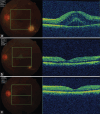Single Low-dose Suprachoroidal Triamcinolone Acetonide Injection in Macular Edema Secondary to Noninfectious Posterior Uveitis
- PMID: 38435103
- PMCID: PMC10903718
- DOI: 10.4103/meajo.meajo_78_21
Single Low-dose Suprachoroidal Triamcinolone Acetonide Injection in Macular Edema Secondary to Noninfectious Posterior Uveitis
Abstract
Purpose: The purpose was to study the anatomical and functional outcome following single low-dose suprachoroidal triamcinolone acetonide (LD-SCTA) (2 mg) injection in noninfectious posterior uveitis.
Methods: Eleven patients with macular edema (ME) more than 280 μ secondary to noninfectious uveitis were included in the study. A single LD-SCTA (0.5 ml) injection was performed in the study eye with the help of a novel suprachoroidal microneedle (Pricon, Iscon Surgicals, Jodhpur, Rajasthan, India). The study parameters were noted at 4 and 12 weeks post LD-SCTA injection.
Results: Ten of 11 patients had a significant decrease in central macular thickness (CMT). The mean CMT measurement at baseline was 513.6 ± 191.73 μm for the 10 patients who responded to the treatment, which reduced significantly to 265.1 ± 34.72 μm (P < 0.003) and 260.6 ± 34.72 μm (P < 0.002) at 4 and 12 weeks, respectively. The mean best-corrected visual acuity (BCVA) at baseline was 0.84 ± 0.41 logMAR unit which improved to 0.52 ± 0.33 (P < 0.001) and 0.25 ± 0.22 (P < 0.000) at weeks 4 and 12, respectively. The mean intraocular pressure at baseline recorded was 16.36 ± 2.97 mmHg, 19.45 ± 4.80 mmHg (P = 0.06) at 4 weeks, and 17.27 ± 2.53 mmHg (P = 0.35) at 12 weeks. One eye which did not respond to LD-SCTA was a case of recurrent Vogt-Koyanagi-Harada disease.
Conclusion: Single LD-SCTA injection is efficacious in reducing CMT in ME, improving BCVA, and controlling the inflammation in noninfectious posterior uveitis. LD-SCTA can be used as a first-line therapy in noninfectious uveitis over other routes of steroid administration with a favorable outcome and safety profile.
Keywords: Low-dose suprachoroidal triamcinolone acetonide; macular edema; noninfectious uveitis; suprachoroidal triamcinolone.
Copyright: © 2024 Middle East African Journal of Ophthalmology.
Conflict of interest statement
There are no conflicts of interest.
Figures






Similar articles
-
Efficacy and Safety of Suprachoroidal CLS-TA for Macular Edema Secondary to Noninfectious Uveitis: Phase 3 Randomized Trial.Ophthalmology. 2020 Jul;127(7):948-955. doi: 10.1016/j.ophtha.2020.01.006. Epub 2020 Jan 10. Ophthalmology. 2020. PMID: 32173113 Clinical Trial.
-
SUPRACHOROIDAL INJECTION OF TRIAMCINOLONE ACETONIDE, CLS-TA, FOR MACULAR EDEMA DUE TO NONINFECTIOUS UVEITIS: A Randomized, Phase 2 Study (DOGWOOD).Retina. 2019 Oct;39(10):1880-1888. doi: 10.1097/IAE.0000000000002279. Retina. 2019. PMID: 30113933 Clinical Trial.
-
Suprachoroidal Triamcinolone Acetonide for Noninfectious Uveitis: Real-World Impact on Clinical Outcomes.Am J Ophthalmol. 2025 Mar;271:259-267. doi: 10.1016/j.ajo.2024.11.022. Epub 2024 Dec 5. Am J Ophthalmol. 2025. PMID: 39645179
-
Suprachoroidal Space Triamcinolone Acetonide: A Review in Uveitic Macular Edema.Drugs. 2022 Sep;82(13):1403-1410. doi: 10.1007/s40265-022-01763-7. Epub 2022 Aug 26. Drugs. 2022. PMID: 36018461 Free PMC article. Review.
-
Suprachoroidal Triamcinolone Acetonide Injection to Treat Macular Edema: A Review.J Vitreoretin Dis. 2024 Oct 17:24741264241275271. doi: 10.1177/24741264241275271. Online ahead of print. J Vitreoretin Dis. 2024. PMID: 39539834 Free PMC article. Review.
References
-
- Rathinam SR, Namperumalsamy P. Global variation and pattern changes in epidemiology of uveitis. Indian J Ophthalmol. 2007;55:173–83. - PubMed
-
- Lee JH, Mi H, Lim R, Ho SL, Lim WK, Teoh SC, et al. Ocular autoimmune systemic inflammatory infectious study –Report 3: Posterior and panuveitis. Ocul Immunol Inflamm. 2019;27:89–98. - PubMed
-
- Pivetti-Pezzi P, Accorinti M, La Cava M, Colabelli Gisoldi RA, Abdulaziz MA. Endogenous uveitis: An analysis of 1,417 cases. Ophthalmologica. 1996;210:234–8. - PubMed
Publication types
MeSH terms
Substances
LinkOut - more resources
Full Text Sources
Research Materials

